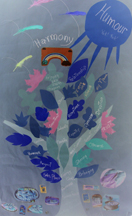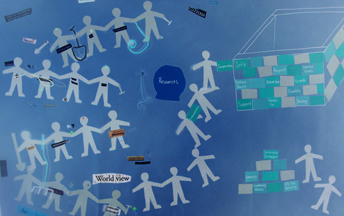The Learning Circles Project |
||
| Process by Guy Ewing |
||
In this project, we took an ethnographic approach to research. That is, we became engaged with learning circles, familiarized ourselves with how they work, listened to the participants talking about them, became part of their world as much as we could, and wrote about them out of this experience of engagement and listening. Our writing took place in several stages. First, we wrote narratives about the learning circles. Then we wrote analysis pieces, focused on aspects of learning circles that seemed particularly important to us. You can find these analysis pieces on this website by going to values and practices of learning circles. This writing became the basis for discussion among the Researchers and the Lifelong Learning Working Group. The discussion was long and complex, continuing as the Researchers continued to meet with learning circles and learn about them. This discussion deepened the analysis and led to new ways of understanding the learning circles as we met with them. This, in turn, led to new questions to explore with the learning circles and among the Researchers. We Researchers began to see ourselves as a learning circle in our own right. And we were also part of a larger learning circle, the Lifelong Learning Working Group, which had begun the discussion about inclusive lifelong learning, and which continued to help us to understand the significance of what we were seeing in the research. In the last year of the project, we brought more people into the process of analysis-through-discussion at a symposium (http://www.nald.ca/learningcircles/symposium.htm). The symposium brought together sixteen participants representing three rural learning circles, three Indigenous learning circles and four urban learning circles. This group also included members of the Working Group, the Researchers, a staff person from the Federation of Women’s Institutes of Ontario and faculty and researchers from the Centre for Aboriginal and Indigenous Studies at the Ontario Institute for Studies in Education of the University of Toronto. Just as we had begun to see the Researchers and the Lifelong Learning Working Group as learning circles, we saw the symposium as a learning circle, one that widened the process of analysis-through-discussion. We called the symposium Widening the Circle. We decide to facilitate the symposium using the approach to learning and knowledge creation that we had observed in the learning circles. We did not tell the participants that we were going to do this, but they soon recognized what was happening, leading to this exchange between Maria Matias, a learning circle facilitator, and Arthur Bull, as he facilitated one of the sessions. Maria: Do you know what I felt yesterday and today? This has been a very positive experience for me, because I found that when we came together, it was . . . The group is kind of, was set up, you know, whoever organizes things, on ones such as simplicity, acceptance, take it as it is. Because there wasn’t these expectations, you know, you know how sometimes you go into a group or a situation and there is these expectations of this professionalism, of this or that or the other, and then you feel, oh, am I going to be able to meet that level, so I’m not going to do anything at all and be vulnerable. Because in here it was based on just be as, come as you are and be as you are and all of that, then all of us, all right, would just be as we are, but then grow a little more from the experience. Arthur: I think you’ve found us out, because this is . . . We thought, “How do you find out about learning circles? You do it with a learning circle.” At the symposium, all of the participants in the circle brought knowledge about learning circles. Members of learning circles brought knowledge from the experience of participation in the various circles. The Researchers and members of the Working Group brought knowledge from their involvement in the project, against the background of their discussions. At the symposium, these kinds of knowledge were negotiated. The result is on this website where you can read from the transcripts of the symposium and see the posters on learning circles which the participants made. You will also find the results of what the researchers learned at the symposium reflected in the:
In this project, our beliefs about research have been clarified. We know that an ethnographic approach to research can be used effectively by adult educators, in this case literacy workers, who are not trained as researchers. We know that analysis can be developed collaboratively, through discussion. We also know that this discussion can be extended beyond the research group to the participants in the study, by applying the inclusive practices that we observed in the learning circles.
|
||

